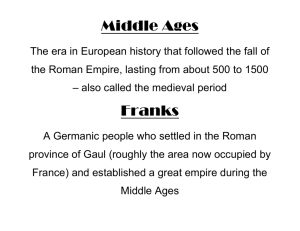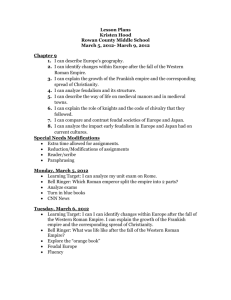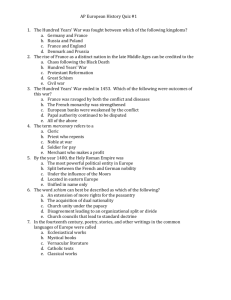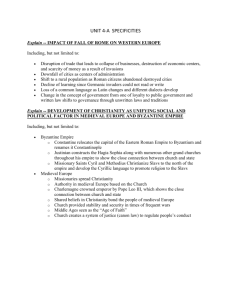Feudalism and Manorialism
advertisement
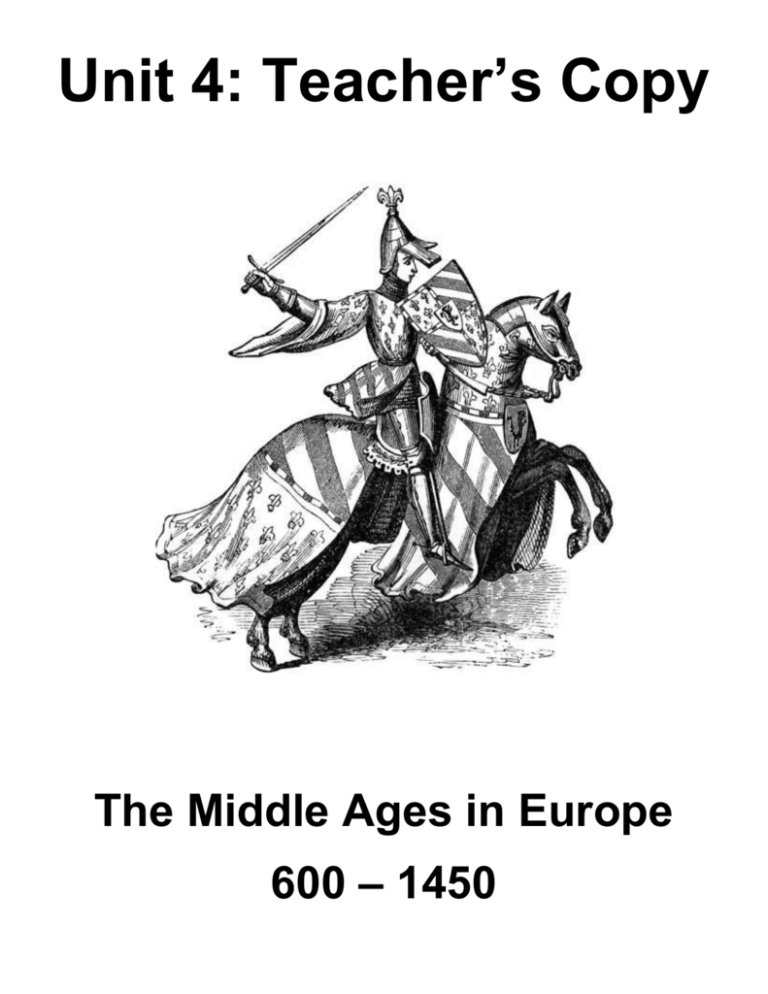
Unit 4: Teacher’s Copy The Middle Ages in Europe 600 – 1450 Decline of Rome/Formation of Medieval Europe Spread of Christianity Causes and Effects for Decline of Rome Decline of Rome and formation of medieval Europe: • Hostile Invaders overrun the empire (Mongols, Huns, Franks, etc.) -Corrupt Governments -Loss of morals and values • Inflation • Roman army cannot defend the empire • People’s loyalty and service to the empire decline • Roman politics decay: Empire is split, an additional capital established (Constantinople), but it doesn’t save it. • People turn to the Church and lords for security and protection • Development of feudalism and strong Church authority in medieval Europe Formation of Medieval Europe IMPACT OF FALL OF ROME ON WESTERN EUROPE …. • Disruption of trade opportunities in the Mediterranean that leads to collapse of businesses, no standardization of currency, inability to collect taxes from the outer edges of the empire, destruction of economic centers, and scarcity of money as a result of invasions • Downfall of cities as centers of administration • Shift to a rural population as Roman citizens abandoned destroyed cities • Decline of learning since Germanic invaders could not read or write …..which is why we call this period the Dark Ages. • Loss of a common language as Latin changes and different dialects develop • Change in the concept of government from one of loyalty to public government and written law shifts to governance through unwritten laws and traditions Early medieval Europe was characterized by less stability and progress. Feudalism MAJOR CHARACTERISTICS AND FACTORS CONTRIBUTING TO FEUDALISM (POLITICAL AND SOCIAL) AND MANORIALISM (ECONOMIC) th th Feudalism – the system of political organization prevailing in Europe from the 9 to about the 15 centuries having as its basis the relation of lords granting parcels of land known as fiefs to lesser knights who are known as vassals, who in turn, provide military service to the lord. • • Characteristics – Lords grant parcels of land known as fiefs to lesser knights who are known as vassals, who in turn, provide military service to the lord. Chivalry and fealty between a lord and the vassal relationship Contributing factors – Fall of the Roman Empire leaves a gap in protection and services to people, invaders overrun communities, people turn to lords for their protection Manorialism Manorialism – Smallest economic, social unit revolving around an estate, controlled by a lord, who gives land and protection to his serfs, who in turn give him their services. Land = wealth • Characteristics – Manors were self-sufficient where serfs raised and produced nearly everything needed for that community. The open field system allowed several families of serfs to farm strips of the same parcel of land. Living conditions for serfs were generally harsh on manors. • Contributing factors – Model of villas in the Roman Empire used to manage rural economies; decline in overland and sea trade after the fall of the Roman empire as well as threats from invaders also promoted the self-sufficiency of a manor Comparing Roman Slaves to Medieval Serfs Increase the standard of living Vocabulary Nation – A group of people sharing a common language, heritage and strong sense of unity. Kingdom – is a community or territory over which a sovereign rules; it is commonly used to describe a kingdom or other monarchical or dynastic state. Nationalism – The belief that people who live within a nation should be loyal to their nation. A strong identification with people in the same nation. Spread of Christianity Spread of Christianity: • Council of Nicea: sets basic tenets of Christianity • Eastern Orthodoxy develops after the schism between that church and the Catholic Church • Church develops in power during the Middle Ages in Europe POLITICAL PHILOSOPHIES OF SPECIFIC INDIVIDUALS • Saint Thomas Aquinas: (1225-1274) Truth is known through reason and faith Aquinas came from a noble family from Naples. He joined the Dominican order against his family’s wishes Aquinas studied with Albert the Great in Paris and participated in the Aristotelian revival of the Middle Ages. He was canonized and became a saint in 1323. Resisting the temptation of a prostitute and the discovery of Herring at night were the miracles used to justify his sainthood. Aquinas’s extensive corpus of scholarship is perhaps a greater miracle han those mentioned above. Ultimate Reality o Aquinas was primarily a Christian theologian. o He viewed human wisdom as structured like a pyramid with the sciences of ethics and politics at its base with philosophy above and theology at its apex. o Natural philosophy are not contradictory but complementary. o Faith and reason are valid in their own realms. o Aquinas’ scholastic method integrates Aristotle’s teleological view of nature into the biblical theology of creation and Christian salvation. DEVELOPMENT OF CHRISTIANITY AS UNIFYING SOCIAL AND POLITICAL FACTOR IN MEDIEVAL EUROPE Medieval Europe • Missionaries spread Christianity • Authority in medieval Europe based on the Church • Charlemagne crowned emperor by Pope Leo III, which shows the close connection between church and state • Shared beliefs in Christianity bond the people of medieval Europe • Church provided stability and security in times of frequent wars • Middle Ages seen as the “Age of Faith” • Church creates a system of justice, canon law, to regulate people’s conduct HOW THE GREAT SCHISM CONTRIBUTED TO END OF MEDIEVAL EUROPE Great Schism of 1054 divides the Eastern and Western Churches into Roman Catholic Church and the Orthodox Church Great Schism • Split in the Catholic Church as two popes claim authority – one in Avignon and the other in Rome; both excommunicate each other from the Church • Authority of the pope as head of the Church challenged by John Wycliffe, who believes that God is sole authority, and Jan Huss, who believes the authority of the Bible is higher than the pope’s authority. Beginning of challenges to the authority of the Catholic Church that leads to the Reformation. CHARACTERISTICS OF ROMAN CATHOLICISM AND EASTERN ORTHODOXY Roman Catholicism • Pope has authority over all other bishops, kings, and emperors • Services conducted in Latin • Priests cannot marry • Divorce is not permitted Eastern Orthodoxy • Patriarch and other bishops lead the church as a collective group • Orthodox Services conducted in Greek or local languages • Priests may marry • Divorce is allowed under certain circumstances ORIGINS/IDEAS/SPREAD OF RELIGIOUS AND PHILOSOPHICAL TRADITIONS Christianity – Through the Middle Ages, the Church becomes the centralizing force of the Western culture. Begun during the Roman Empire Started as an offshoot of Judaism Spread throughout the Roman Empire Promoted the idea of salvation for all Became the most powerful influence in medieval Europe. RELIGIOUS INFLUENCE • The Medieval Church as a unifying force: • Shared beliefs in the teachings of the church • Provided Christians with a sense of security and a religious community to which they belonged • At the local level, the church was the religious and social center. People met there for service, social gatherings and festive celebrations. • Provided a unifying set of spiritual beliefs and rituals • Performed social services such as caring for the sick and the poor. By running hospitals and developing social services for the poor. • The church operated most hospitals in medieval Europe.



